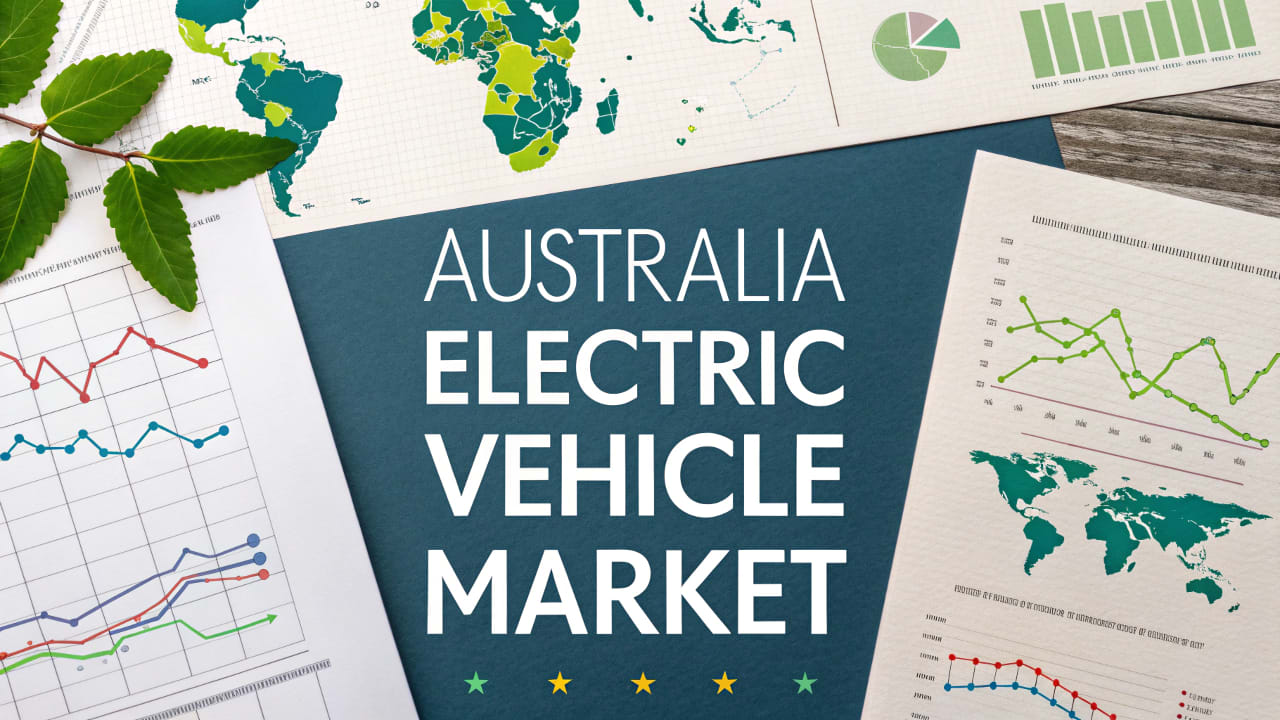Market Overview
- In 2024, Australia’s electric vehicle (EV) market was valued at roughly USD 16.2 billion.
- By 2033, the market is expected to reach USD 171.6 billion, growing at a CAGR of 30.00% between 2025-2033.
- The market covers battery electric vehicles (BEVs), plug-in hybrid electric vehicles (PHEVs), and includes segments by price category, propulsion type, and region. Growth is being boosted by mass production, declining vehicle costs, and increasing EV adoption among both private and commercial buyers.
Key Trends & Market Drivers
- Record high EV sales in 2024: Australians bought about 114,000 new BEVs + PHEVs in 2024—an increase from approx. 98,000 in 2023. BEVs accounted for ~91,000 of that. EVs made up ~9.65% of all new vehicle sales in 2024.
- Policy incentives and regulatory support: Multiple government schemes are helping. These include the Electric Car Discount (tax incentives), cleaner vehicle efficiency standards, and incentives around charging infrastructure. Strategies are being implemented to make EV ownership more accessible.
- Charging infrastructure scale-up: The EV charging infrastructure market in Australia was valued at USD 250.5 million in 2024 and is forecasted to reach USD 1,643.1 million by 2033, with a CAGR of ~21.5%. This reflects both urban and rural deployments, fixed and fast chargers, and increasing attention to smart technologies like vehicle-to-grid systems.
- Hybrid EV adoption also rising: Hybrid vehicles (HEVs and PHEVs) continue to be viewed as transitional options, especially among consumers concerned about range or charging availability. In 2024, ~360.2 thousand hybrid units were sold, and this is expected to grow substantially through 2033.
- Components & supply chain expansion: Related markets like e-axles and batteries are growing fast. The battery market, for example, was valued at USD 1,531.80 million in 2024, and is forecasted to hit USD 12,235.06 million by 2033, at a CAGR of ~25.97%.
Get a PDF & Request Free Sample Report: https://www.imarcgroup.com/australia-electric-vehicle-market/requestsample
Opportunities in the Australia Electric Vehicle Market
- Mass-market, affordable EVs: There is huge potential in lower-priced electric vehicles. Brands able to offer EVs under competitive price points will likely capture larger portions of the consumer market. Competition from Chinese brands (e.g. BYD, MG) is especially relevant here.
- Commercial fleet electrification: Businesses, government fleets, and utilities are under pressure to reduce emissions. Converting light commercial vehicles, service fleets, and delivery vehicles offers high volume opportunity. Policies that favour clean fleet procurement can accelerate this.
- Charging infrastructure & smart grid integration: Investing in fast chargers, vehicle-to-home (V2H) and vehicle-to-grid (V2G) technologies, ensuring accessible chargers in remote/rural areas, and integrating renewables into charging networks are major growth levers.
- Aftermarket & maintenance services: As EV penetration grows, the demand for servicing, diagnostics, battery maintenance, and replacement will grow. The Australia EV aftermarket is forecasted to grow from USD 1.6 million in 2024 to USD 8.8 million by 2033.
- Regulatory frameworks & incentives: State-level rebates, exemptions from stamp duty or registration, fuel-efficiency standards, tax breaks—these policies can either accelerate or hinder adoption. Investors or automakers who align with and anticipate regulatory changes will benefit.
- Component manufacturing & local supply chain: Battery production, e-axle manufacturing, and related supply chain elements are growth areas. Reducing import dependency and localizing key parts can yield both economic and strategic advantage.
Recent News & Developments in the Australian Electric Vehicle Market:
- EV Sales Record in 2024: Australia recorded about 114,000 EVs (BEV + PHEV) sold in 2024—setting a new high. EV market share among new cars rose to ~9.65%.
- Mining Industry Fleet Trials: BHP began trialing a battery-electric Toyota HiLux at Port Hedland, WA, for a year in 2024. This is part of a broader commitment by BHP to electrify its light vehicle fleet and reduce emissions.
- BMW’s New EV-Focused Model: BMW revealed its new iX3 50 xDrive under its “Neue Klasse” strategy. Scheduled for Australia by mid-2026, this EV claims ~805 km range and fast-charging capability (adds ~350 km in 10 minutes), targeting premium long-range buyers.
- Discussion Around EV Road User Charge: As EV adoption grows, governments are contemplating road user charges to offset lost fuel excise revenues. The federal government has signaled a cautious or “go-slow” approach, tying implementation to milestones like 30% EV market share.
- Salvaged EV Batteries Gaining Value: Written-off EVs are increasingly sought after for their lithium batteries, which are being repurposed for energy storage (e.g. solar systems, events) especially in Queensland. Demand for second-life battery reuse is growing rapidly.
- Chinese EVs Gaining Share: Chinese brands (particularly BYD) are becoming highly competitive due to affordable pricing, filling niches that previously had fewer EV options in Australia. This is reshaping pricing dynamics and consumer expectations.
Browse Full Report with TOC & List of Figures: https://www.imarcgroup.com/australia-electric-vehicle-market
Australia’s EV market is at a tipping point. With projections showing growth from USD 16.2 billion in 2024 to USD 171.6 billion by 2033, this isn’t a slow transition—it is a rapid systemic shift. For automakers, charging infrastructure providers, battery manufacturers, and investors, the opportunity span covers almost everything: vehicle production, supply chain localization, software and services, charging and grid upgrades, and policy engagement.
For consumers, rising adoption means more model choices, lower costs through economies of scale, and a more reliable charging ecosystem. For governments, EVs offer a pathway to emissions reductions, cleaner air, and meeting climate goals, but they also present revenue challenges (like lost fuel excise) and infrastructure demand.
Aligning with favorable incentives, staying ahead of regulatory change, and focusing on accessible, affordable EV options are likely to yield strong returns. Moreover, innovations in battery reuse, second-life applications, and smart charging will add layers of value beyond just vehicle sales.


